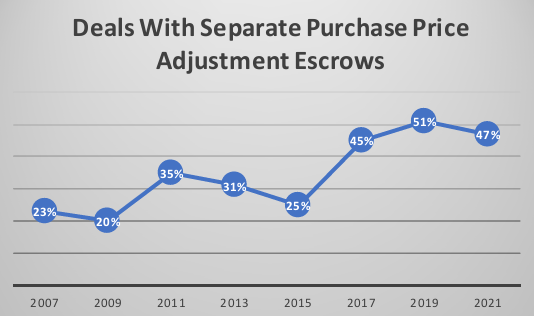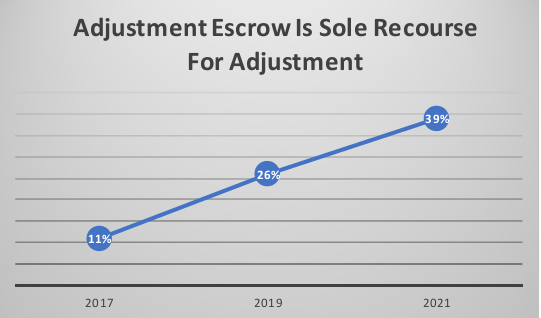Goulston & Storrs M&A attorney Dan Avery is a nationally recognized expert on M&A deal point trends. In partnership with Bloomberg Law, Dan has developed a series of 25 articles looking at these trends, on a topic-by-topic basis, providing practical insight into where these trends are heading, and the relevant implications for M&A deal professionals.
Market Trends: What You Need to Know
As shown in the American Bar Association's Private Target Mergers and Acquisitions Deal Point Studies:
- The use of separate escrows for purchase price adjustments has been increasing on a fairly steady basis since 2007 (with a slight dip in 2021 from a 2019 high).
- Separate purchase price adjustment escrows were present in 47% of the reported deals in the 2021 study.
- In the last three ABA studies to look at the issue, sole recourse limitations on adjustment escrows have increased in usage from 11% to 26% to 39%.
Introduction
In mergers and acquisitions (M&A) transactions, the definitive purchase agreement, whether asset purchase agreement, stock purchase agreement, or merger agreement, typically contains provisions for post-closing purchase price adjustments. Generally, these adjustments are intended to reconcile changes in the target's financial condition as of the transaction's closing, usually measured against a prior date or against representative or average historical financial metrics. In many M&A agreements with a purchase price adjustment, the parties agree to escrow a portion of the purchase price for a limited period following the closing. This article examines trends relating to the use of separate escrows for purchase price adjustments in private company M&A transactions.
Purchase Price Adjustment Provisions
Purchase price adjustments are designed to ensure that the parties receive the full benefit of the bargain that was agreed to at signing. For example, on Jan. 1, a transaction is valued, or priced, at $10,000,000 when the target has inventory worth $100,000. If, when the transaction closes, all other financial metrics being equal, the seller delivers the target with $500,000 of inventory, the seller will expect to be paid, often dollar-for-dollar, for the additional $400,000 of added, measurable value. Alternatively, if at closing the target's inventory is valued at $50,000, the buyer would expect a $50,000 reduction in the purchase price due to the depleted inventory value. Because purchase price adjustments are intended to put the parties on an equal footing, as of the closing date, these provisions are not normally viewed as favoring the buyer or seller.
Once the parties have agreed upon a purchase price and to include a purchase price adjustment in the purchase agreement, the lawyers are often asked to memorialize three aspects regarding the purchase price adjustment:
- The particular financial metrics to be used;
- Setting the benchmark amount against which the corresponding closing amount is to be measured; and
- The specific procedures for calculating the adjustment before or after closing.
In addition to these aspects, buyers and sellers are increasingly considering establishing a separate escrow to secure payments due as a result of a purchase price adjustment.
M&A Escrows
In most M&A transactions, a portion of the purchase price otherwise payable to the seller is placed into escrow for a defined period of time to secure one or more obligations of the seller to the buyer following closing. Escrows are typically set up as security for the seller's general indemnity obligations regarding its representations and warranties, but they need not be limited to those obligations. The parties may agree to establish a single escrow to secure all potential claims, or establish multiple, separate escrows with each providing recourse for different seller obligations. For example, if the buyer discovers something in diligence that warrants negotiation of enhanced rights and remedies, it may also negotiate for a separate escrow, apart from the standard general indemnity escrow, to ensure funds are available if any of the enhanced remedies are triggered.
A seller's potential obligation to make payments to the buyer as a result of a post-closing purchase price adjustment could, like any other seller obligation, be the subject of a separate escrow. Typically, a post-closing purchase price adjustment is determined quickly after closing, within 6 months, whereas a seller's general indemnity obligation may last much longer. Perhaps even more important is buyers and sellers usually have, at closing, a reasonable understanding of the likely financial parameters for a post-closing adjustment. This is particularly true if the adjustment is based on fundamental financial measures, such as working capital. This allows the parties to implement part of the expected adjustment at or prior to closing, thereby reducing the risk that either party will owe the other an unexpected material amount following the closing. Given these practical considerations, until the last few years, purchase price adjustment escrows were only seen in 20-35% of private company M&A transactions. More recently, however, these escrows have become more common.
Trends as to Purchase Price Adjustment Escrows
Every other year since 2005 the ABA has released its Private Target Mergers and Acquisitions Deal Point Studies (ABA studies). The ABA studies examine purchase agreements of publicly available transactions involving private companies. These transactions range in size but are generally considered as within the “middle market” for M&A transactions; the transaction values of the 123 deals within the 2021 study ranged from $30 to $750 million.
The ABA studies show that the use of separate escrows for purchase price adjustments has been increasing. Now the majority approach, in the 2021 study, 47% of the reported deals included a separate purchase price adjustment escrow. 12+ years earlier, less than a quarter of reported deals included a separate purchase price adjustment escrow. The chart below shows this trend.
Source: ABA Private Target Mergers and Acquisitions Deal Points Studies


The last three ABA studies for 2021, 2019 and 2017, respectively, have looked at whether the separate adjustment escrows constituted the sole recourse for adjustment recovery. As shown below, the prevalence of these types of “sole recourse” provisions is on the rise.
Source: ABA Private Target Mergers and Acquisitions Deal Points Studies


Conclusion
Many provisions in an M&A purchase agreement reflect an allocation of risk between the seller and buyer, such as those relating to financial matters, or compliance with laws or labor and employment, that taken together reflect a compromise of the parties’ different perspectives. In contrast, purchase price adjustments are considered to be neutral between the parties. These provisions are linked, often dollar-for-dollar, to the purchase price, in amounts that should be determinable shortly after closing. The adjustment provisions, while usually straightforward, are nonetheless important to ensure that the parties receive the economic results bargained for, and therefore may be the subject of a separate escrow. Separate escrows for purchase price adjustments are increasingly seen in private company M&A deals, and “sole recourse” limitations on these escrows are on the rise; counsel for buyers and sellers should be prepared to address these escrows (and these sole recourse provisions) as they continue to become more common.
Click here for a pdf of the article.
Reproduced with permission from Bloomberg Law. Copyright ©️2022 by The Bureau of National Affairs, Inc. (800-372-1033) http://www.bloomberglaw.com.

/Passle/630ddfd8f636e917dcf6e4ce/SearchServiceImages/2024-04-22-16-48-04-221-662694c48171a252db3820bd.jpg)
/Passle/630ddfd8f636e917dcf6e4ce/SearchServiceImages/2024-04-22-15-12-36-997-66267e64d100dba38ac045e7.jpg)
/Passle/630ddfd8f636e917dcf6e4ce/MediaLibrary/Images/2024-04-22-13-15-13-552-662662e18171a252db378c86.png)
/Passle/630ddfd8f636e917dcf6e4ce/MediaLibrary/Images/2024-04-10-02-23-24-827-6615f81c7f643c6b40a522fc.png)